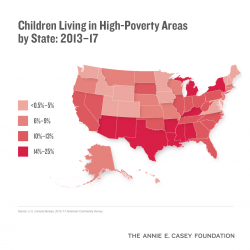
Note: This blog is the fourth and final in a series of posts covering the findings in the Annie E. Casey Foundation 2019 KIDS COUNT® Data Book. To read the first blog post on economic well-being, click here; to read the second post on education, click here; to read the third post on health, click here; and read our press release here.
This week, we’re looking closely at the Annie E. Casey Foundation’s KIDS COUNT rankings, which were released Monday, and assessing where Arkansas needs improvement in child well-being.
One of the areas in which our state’s ranking is stubbornly low is in the Data Book’s “family and community” category of measurement. It tracks teen births, single-parent households, children living in households in which no one has a high school diploma, and the percentage of kids living in “high poverty” areas.
We’re ranked 45th nationally in this category, the same as last year. Even though we’re actually improving across all the indicators, we’re not improving as fast as other states.
The most persistent example of this is teen births, where we’re ranked 50th. We’ve been stuck at or near last place for most of this decade. In 2017, the most recent data in KIDS COUNT, Arkansas had 33 births per 1,000 girls and women aged 15 to 19. That’s down from 52 per 1,000 in 2010, but we’re perennially in last place because our gradual improvement is outpaced by measures implemented in other states.
So, what can we do about it? One thing we could do is adopt evidence-based reproductive education in our schools. These types of education programs have been shown to have a positive impact on preventing teen pregnancies, sexually transmitted infections, or risky sexual behaviors. We also need consistency statewide. While some sex education is covered in health class in Arkansas, the state doesn’t require public schools to teach sex ed. It’s up to local school boards to decide. States that have lower teen birth rates tend have more consistent sex ed policies.
Here’s how we fared in other indicators that are part of the family and community category:
- 37 percent of children in Arkansas lived in single-parent households in 2017, a slight improvement over 39 percent in 2010. Our national ranking in this category is 36th, an improvement over 44th in 2010. This indicator is highly correlated with poverty and lower education levels. And the relationship between single parent families and poverty goes in both directions. Single parent families often occur because of unplanned or unintended pregnancies, which tend to occur at a high rate among teen moms.
- 13 percent of children in 2017 lived in households in which no parent had a high school diploma. That’s a decrease from 17 percent in 2010. That year, Arkansas was ranked 44th nationally, and now the state is ranked 41st. This indicator is also highly correlated with poverty. Parents who have more education and training are more likely to land better-paying jobs, as well as more fully participate in their own children’s educations.
- 14 percent of Arkansas children lived in high-poverty areas in 2017. That’s defined as those children who live in Census tracts in which the child poverty rate is 30 percent or higher. We’ve made improvement here as well, with a drop from 17 percent in 2010. Still, about 100,000 children live in high-poverty areas, which are less likely to have the types of resources and opportunities available to allow children to reach their full potential.
Download the entire 2019 KIDS COUNT® Data Book here. You can also find Arkansas-specific information at that page.
